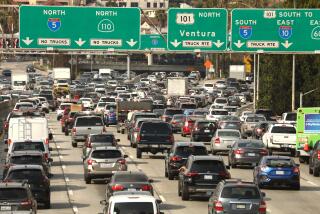Worker Comp Fix in Doubt
- Share via
SACRAMENTO — Gov. Arnold Schwarzenegger promised “billions and billions” of dollars in savings when he signed a landmark overhaul of the state’s workers’ compensation system at a Long Beach aircraft factory back in April.
But five months later, bureaucrats are struggling to craft rules to implement the complex legislation, with the first deadline only 45 days off. And lawyers, industry lobbyists and union officials are arguing about exactly what it was they agreed to when the workers’ comp bill was rushed through the Legislature.
For California businesses, the behind-the-scenes turbulence could mean they will see little or no significant savings when they open their workers’ comp insurance bills beginning in January.
“Everyone wants to think it was fixed because they had a press conference at Boeing,” said Robert Vines, an Ontario attorney who represents injured workers. Overhauling workers’ comp is “like the war in Iraq; they didn’t plan for what we’d do after we declare victory.”
The disarray is expected to be a prime topic today when state Insurance Commissioner John Garamendi convenes a hearing on a proposal to raise premiums by 3.5% on workers’ comp policies that start or renew in the first six months of 2005. Industry researchers said the hike was needed to reimburse insurers for a previously scheduled boost in injured workers’ benefits.
“We can’t do a thing” about cutting rates until regulations are issued and their financial impact can be assessed, said Stanley Zax, president of California’s fifth-largest workers’ comp carrier, Zenith National Insurance Co. “Hopefully, the costs are going to go down. But they haven’t gone down yet.”
Schwarzenegger’s much-ballyhooed workers’ comp law made wholesale changes to the state’s troubled $20-billion system for providing medical treatment and financial benefits to victims of workplace injuries. The latest restructuring, combined with legislation approved in 2003, halted a trend that had pushed workers’ comp costs up by 80% from 1998 to 2003. Since then, premiums have fallen about 10%, less than many employers anticipated.
Despite the limited success, few are ready to declare the governor’s effort a failure.
“I’m expecting significant drops in our costs over the next several years,” said William M. Zachry, vice president for workers’ comp at Pleasanton, Calif.-based Safeway Inc. Nevertheless, Zachry conceded that the biggest savings “have not hit the bottom line yet.”
For business owners awaiting the 30% drop in premiums promised by Schwarzenegger, the slack pace of rate reductions is frustrating -- if not unexpected.
“The politicians want everyone to believe that the rates will go down, that they’ve overcome all the problems with the system,” said David Oliver, president of retailer Ames Stores of Culver City. “But the reality is that the insurance companies are going to have to see it before they believe it. That’s going to take time.”
More than 200 bureaucrats and government attorneys here are laboring over the new workers’ comp rules while being pushed and prodded by a half dozen interest groups, including employers, insurers, unions, doctors, medical suppliers and workers’ comp lawyers.
At the center of the storm is Andrea Hoch, the newly appointed director of the state Division of Workers’ Compensation. She is determined to meet her deadlines. “I’ll make it happen,” she vowed.
But Hoch’s mettle is being tested. Business lobbyists and labor unions are jousting over several mandates in the new law, including a change in the way disability benefits are calculated.
Businesses believe that the changes are intended to reduce payouts to injured workers and thus lower workers’ comp costs and premiums. Unions contend that the issue isn’t the amount of money awarded, but how and to whom it’s paid.
The battle over the permanent disability rules could be bitter. The law requires the state to junk a long-standing system that bases monetary benefits on an injured worker’s diminished ability “to compete in the marketplace.” Now, benefits must be calculated using a new formula that combines medical industry guidelines with estimated wage losses for dozens of different workplace injuries.
The new schedule of benefits, though far from finished, will “result in cost savings,” Hoch said.
But that’s not how labor unions recall the intent of the deal cut with Schwarzenegger when they agreed to create a permanent disability rating system based on lost wages. They worry that the new system could become a smoke screen for cutting benefits for people who can no longer work at their old jobs.
“We are not going to stand for the insurance companies and the employers controlling a regulatory process in this administration that whacks at injured workers,” said Angie Wei of the California Labor Federation.
The two sides also are arguing over a new concept of using health maintenance organizations, rather than individual doctors, to evaluate and treat workers’ injuries.
Despite the bickering, Hoch said the first batch of regulations should be completed by Nov. 1. The permanent disability rules will be out by New Year’s Day, she said.
Widespread discord over workers’ comp regulations could turn into a lose-lose situation for both employers and employees if the overhaul fails to deliver both real savings and adequate medical care, warned Michael Weinper, president of PTPN Inc., a Calabasas-based provider of occupational therapy services.
“There’s going to be an employer backlash,” he said, “because many of us thought this would be a fix.”
More to Read
Inside the business of entertainment
The Wide Shot brings you news, analysis and insights on everything from streaming wars to production — and what it all means for the future.
You may occasionally receive promotional content from the Los Angeles Times.











